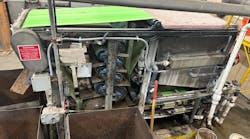If the city of Martinsville, Va., sounds familiar, you may remember it from the recent NASCAR racing event that drew thousands of fans and media to the town of 15,000 and its 60-year-old speedway. Just down the road from that venue, the Martinsville Wastewater Treatment Plant (WWTP) found itself facing two challenging situations.
With the surge in popularity of NASCAR racing, the speedway figured to remain a major tourist destination for the foreseeable future—at least if odor emanating from the plant could be controlled. Secondly, with the closure of the city’s municipal landfill, sludge haul-out expenses were rising exponentially for the use of private facilities, including increases in tipping fees, new state taxes and ordinary inflation costs such as fuel.
About one year ago, plant supervisors agreed it was a good time to examine the entire method of treating wastewater and water for Martinsville. There was a lot of experience in house, and the city had developed a variety of comprehensive treatment schemes for both residential and industrial applications over the years. The reality, however, was that things had changed over the past couple of decades.
While most of the effluent is now residential, Martinsville at one time had much more industrial wastewater coming through its three treatment plants—two of which now serve as pumping stations to the main plant. The area was formerly a textile center for the region, but Martinsville has experienced a declining population with the exodus of those plants. Whereas the city once stayed plenty busy treating for color in dyes, industrial oils and the like, today it is plenty busy figuring out ways to economize.
Cost Analysis
Typical for plants of its type, the Martinsville WWTP treats total suspended solids, biochemical oxygen demand and E. coli using extended aeration. Ferric chloride and lime are used for sludge processing and discharging for further treatment, and the city has a 9,000-gal mixing tank for this stage of the operation.
Originally, Martinsville used aerobic digestion with belt presses—a workable combination but surely not the most efficient one under the circumstances. The city was spending $180,000 annually on aerobically digesting the sludge. The process was fairly easy to operate but did not take wide swings in loading and could cause odor problems when mechanical problems occurred. The cost of electricity also had risen significantly since the original evaluation was done. The basic math was based on electricity and demand to run two 200-hp blowers 24/7.
Tipping fees went from about $35 per ton to about $42 per ton during the evaluation period. The city’s actual cost went from $320,000 per annum to $420,000 per annum. If Martinsville could double the solids from what its belt presses were achieving, the plate press would come close to cutting sludge disposal in half, with the exception of an additional cost for the lime bulking.
The city estimates that the electrical cost will experience almost complete reduction and that the disposal cost will be halved, resulting in savings of $340,000 per annum. Officials will have to subtract the cost of lime plus the cost of landfilling the lime, which will be approximately $80,000 per annum. These numbers are based on the original costs, not the new, higher costs for disposal and electricity. Actual savings could exceed the original estimate.
Solutions & Benefits
Realizing the scope of its needs, Martinsville wanted to work with a manufacturer that designed and built its own equipment and could follow up with a service program to keep systems optimized. Beckart Environmental, Kenosha, Wis.—maker of the Hy-Pack line of filter presses and Aqua3000 chlorine dioxide (ClO2) generators—turned out to be that company.
The Hy-Pack press has a recessed plate design. With the city’s need to process about 4.5 million gal per day, Beckart helped determine a proper capacity of 125 cu ft for each of two, which are equipped with 1,200-mm polypropylene plates. While the presses have automatic plate shifters, Martinsville built a catwalk to accommodate cake dumpers below and to create access for routine maintenance such as cleaning and replacement of the filter cloths. Because so much of the haul-out expense is determined by weight, the relatively high solids content of the residual dry filter cake as compared to sludge processed with belt presses has helped the city realize a savings estimated at $200,000 per year.
Though its main consideration was the cost savings to be achieved by approximately doubling the solids in the filter cake, Martinsville has since found other benefits as well. The cake dewaters well, dries quickly and requires fewer dumps due to its high density. Additionally, the filtrate water that is recirculated back to the secondary system is considerably cleaner than that of a belt press, so subsequent treatment chemical costs are lower and the city can be confident of fewer system upsets and fairly assured of a less challenging recirculation schematic in general.
During the course of various discussions on the plant’s water and wastewater treatment needs, the city learned that Beckart had recently begun marketing a patented ClO2 system that would work well for its odor problem. The solution was simpler and less expensive than alternative options such as pulling air through hooded systems. For one thing, those systems have a higher capital cost—probably five times or more that of Martinsville’s selection—and higher operational expenses. Also, in hindsight, the city realizes that it is constantly looking into those tanks; it is generally simpler to not have to frequently raise and lower any apparatus sitting on top.
But again, efficiency was the deciding factor. By eliminating the contaminant at the source, any other equipment, process and handling issues are taken out of the equation.
Martinsville located its ClO2 system adjacent to a trough at the head of the plant, where the compound is automatically and continuously fed in small amounts to help disinfect the wastewater. The Aqua3000 also has a reservoir that allows use of small quantities for particular applications. Every time the city fills a tank for sludge processing, plant staff adds about a liter of ClO2 to the mixing tank.
One of the unique features of the Aqua3000 ClO2 generator is the single-stage design of the system. There are no mixing or complicated formulas involved, and consequently the system provides minimal handling and safety issues. While it is still a fairly new technology (it has only been patented within the past couple of years), it has been working well for Martinsville.
The city was able to rent its ClO2 system before deciding to buy one permanently. This case is just one example of how more enterprising manufacturers are coming up with ways to make it easy to try new technologies in an age where WWTPs have to keep a close eye on system effectiveness and costs.
Download: Here

